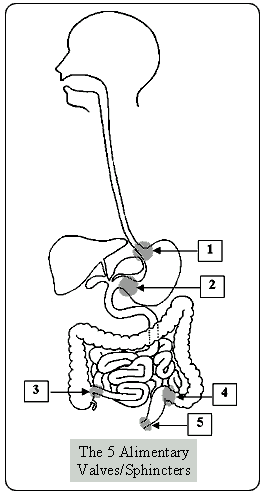
|
||||
Other cleansing techniques |
||||
| Shankaprakshalana - The Intestinal Wash | ||||
| Anatomy of Shankaprakshalana
Normally each of these sphincters is controlled involuntarily by the body's own timing and control systems, but what happens after many years of bodily neglect or abuse, is that they lose their natural function, become inefficient and gradually the system starts to pack up. This causes what is known as auto-toxemia, a state where the body's own wastes begin to poison itself. Poor food, sedentary lifestyles, late eating hours, habitual snacking and dehydration, are also common reasons that the digestive system will become inefficient at assimilating and eliminating. More than just some salty water, the whole of ones lifestyle needs to be addressed for long-term digestive health. The water going through and all the exercises performed, along with all the breathing in and out being done during the practice, gently massage those valves to relax and open up. It works to recondition the function of the valves, the organs connected to them and their corresponding nervous control systems, giving better voluntary control of those, normally, involuntary activities. The intestines get a good wringing out and any stuck matter is moved into the water and eliminated very quickly. Normally when food passes through the GIT, due to a positive osmotic pressure, all the salts, chemicals and nutrients in the food pass through the intestinal membranes and are absorbed into the blood stream. For many people this happens only poorly, and much of the potential food goodness is lost and excreted, due to waste matter permanently lodged in the little nooks and crannies of the intestines which in turn has caused reduced internal diameter of the passages and poor transfer across the cells. The warm salty water firstly dissolves all this matter, to get the walls clean. It is an interesting phenomenon, that once the physical matter is removed from the walls, due to a negative osmotic pressure caused by the salt in the water, the water then starts to draw salts, acids and toxins out of the bloodstream, and into the water for elimination. This is truly an amazing thing the yogis discovered. Here we have a method of actually purifying the blood and back-flushing the intestinal wall cells. The result afterwards is a clean lining, more efficient chemistry in the GIT and a reversal of toxic accumulations in the blood. Another aspect which the technique addresses is the function of the auxiliary organs of digestion: that is the liver, the gall bladder, pancreas and spleen. At various points along the passage of our food, these organs inject into, or draw certain substances from, the intestines. During Shankaprakshalana, as the water passes through, it cleans out these ducts and organs, initially removing the blocked matter, but later on drawing out the toxic substances lodged within the tissue of those organs themselves. For example, the continual exercising and drawing effect helps to dislodge and breakdown gall stones which can be seen to pass out in the water. So we see that there are many, many elements to this deeply rejuvenating technique. Perhaps there are other aspects of anatomy and physiology which Shankaprakshalana addresses, of which we are not currently aware, but the evidence of the many students who have undergone this practice over many years, gives support to so many claims of its incredible health giving benefits. |
||||
| About | | | Contact | | | Disclaimer |
 As
shown on the diagram, there are 5 valves or sphincters in our food
passage. At any stage of our digestive system, muscular tensions,
emotional tensions and even mental tensions, can restrict the flow
in the system. For example, some people may tend to accumulate their
tensions primarily in the stomach region, and therefore the oesophageal
valve (#1) or the pyloric valve (#2) may be the most inactive. Others
may have a blockage around the ileocecal valve (#3), and others
at the colon (#4) or anus (#5). At the anus there are in fact two
sphincters, an inner and an outer one, both of which need to co-ordinate
to work properly. The complexity of the GIT, and its sensitivity
to day to day tensions, is why so many people today are constipated,
and why so many especially have so much trouble with relaxing their
bowels when required.
As
shown on the diagram, there are 5 valves or sphincters in our food
passage. At any stage of our digestive system, muscular tensions,
emotional tensions and even mental tensions, can restrict the flow
in the system. For example, some people may tend to accumulate their
tensions primarily in the stomach region, and therefore the oesophageal
valve (#1) or the pyloric valve (#2) may be the most inactive. Others
may have a blockage around the ileocecal valve (#3), and others
at the colon (#4) or anus (#5). At the anus there are in fact two
sphincters, an inner and an outer one, both of which need to co-ordinate
to work properly. The complexity of the GIT, and its sensitivity
to day to day tensions, is why so many people today are constipated,
and why so many especially have so much trouble with relaxing their
bowels when required.